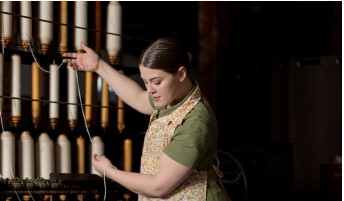Last updated: January 4, 2024
Lesson Plan
History Detective: First Strike!

- Grade Level:
- Middle School: Sixth Grade through Eighth Grade
- Subject:
- Social Studies
- Lesson Duration:
- 90 Minutes
- State Standards:
- D2.His.1.3-5, D2.His.16.3-5, D2.Eco.4.3-5, E 1 (3-4) –1, E 2 (K-2) – 2
- Thinking Skills:
- Understanding: Understand the main idea of material heard, viewed, or read. Interpret or summarize the ideas in own words. Analyzing: Break down a concept or idea into parts and show the relationships among the parts. Evaluating: Make informed judgements about the value of ideas or materials. Use standards and criteria to support opinions and views.
Essential Question
How do individuals and communities fight an injustice?
Objective
1) Students will analyze primary sources from the first wage workers strike in Pawtucket, RI.
2) Students will put together a timeline of important events surrounding the strike in May/June 1824.
3) Students will share what they have learned with classmates and compare findings.
Background
What would you do if you were asked to work one hour longer each day without additional pay? Would you stop working if you learned that you would be paid 25% less by your employer? In late May 1824, young women in Pawtucket, RI, were faced with such dilemmas.
In response to cuts in pay and longer days, “the most unprincipled and disorderly part of the village” set out to disrupt the system of local manufacturing. Afterward, the mills did not run, and local men and women were accused of leading a “riot.” In early June, the mills began operating again, following an agreement between the workers and mill owners. We do not know exactly how this situation was resolved.
Historians use evidence to draw conclusions about the past. Sometimes, we are still left with uncertainty and there is a lot that we don’t know about this strike. How exactly did people find resolution in June 1824? Using primary source documents, students will piece together their own version of the story and engage in historical research.
Preparation
In preparation for this lesson, have students watch the following video created by the Park in collaboration with Metamorphosis Dance Company about the First Strike: The First Strike (youtube.com)
Materials
This worksheet is intended for students to use while analyzing primary source materials.
Download Primary Source Analysis Sheet
These documents will be used by students to analyze what happened
Download 1824 Strike Primary Source documents
Diary entries about the strike
Download George Foster Jenks Diary
Lesson Hook/Preview
What would you do if you were asked to work one hour longer each day without additional pay? Would you stop working if you learned that you would be paid 25% less by your employer? In late May 1824, young women in Pawtucket, RI, were faced with such dilemmas.
Procedure
- Read newspaper articles and diary entries from Pawtucket in 1824 to learn about the country’s first wage worker strike.
- Complete the analysis worksheets.
- Create a timeline of what we know occurred in Pawtucket in May and June 1824 - use evidence to develop a claim about the past.
- Generate interview questions. Imagine you are able to sit down with a person who participated in the strike. Who would you want to speak with and what would you ask them? Explain your choice for the interview.
- You are also encouraged to watch a dance video on the “First Strike” created with Metamorphosis Dance Co. and Run of the Mill. Consider how artists and historians make sense of the past. Write a letter to someone who’s never heard of this event in history. What are the most important facts and observations to share?
- If possible, visit Old Slater Mill for a self-guided or guided tour.
Assessment Materials
Reflect upon the document.What is the main idea of the article?Use text evidence (quotes or words from the document) to support the main idea. Why do you think this article was written?What questions do you still have about this article?
